
Blue Ocean Strategy: Outsmart Your Competition with Mastery!
The aim of every company is to generate profit and continuously drive the business forward. To achieve this, it is necessary to regularly compare with competitors and venture into uncharted territory to develop new ideas.
This is where the Blue Ocean Strategy comes into play. Keep reading to find out how you can discover market gaps and generate long-term success with this strategy.
What is the Blue Ocean Strategy?
The Blue Ocean Strategy was developed by economists W. Chan Kim and Renée Mauborgne in 2005 and falls within the realm of strategic management.
In their book “Blue Ocean Strategy: How to Create Uncontested Market Space and Make the Competition Irrelevant,” they extensively describe the strategy and differentiate between the Blue Ocean and the Red Ocean (see paragraph “What are the differences between Blue Ocean and Red Ocean”).
These strategies are metaphorical in nature: Two business-relevant poles are juxtaposed. The blue ocean symbolizes a market or industry that has not yet been depleted by competitors. This serves as the growth concept for your company. On the other hand, the red ocean represents saturated markets into which no company should enter due to intense competition.
What is the goal of the Blue Ocean Strategy?
The goal of the Blue Ocean Strategy is for successful companies to not align themselves with others. Instead, they follow their own concept and find themselves in a sub-market where there is little to no competition.
That is the aim of the Blue Ocean Strategy: to disregard competitors and instead venture into completely new areas, creating a unique selling proposition that ensures entrepreneurial success.
By differentiating themselves in a unique way, companies will remain in the minds of customers as market leaders, even if competitors try to jump on the same bandwagon.
“You can’t overtake someone if you’re walking in their footsteps.”
François Truffaut
Therefore, the Blue Ocean Strategy aims to identify market gaps and promise profitability to your company by charting new paths without existing competition. Other goals include:
What is the difference between Blue and Red Ocean?

Chan Kim and Mauborgne distinguish between the Blue Ocean and Red Ocean. The Red Ocean represents fiercely competitive markets, metaphorically stained red with the attacks of predators. In contrast, the Blue Oceans are untouched and completely free from competitors.
The Red Ocean encompasses saturated markets where no company should enter due to intense competition. It is important to note that you can also create a Blue Ocean yourself, as it is not about finding a market but rather creating one. By doing so, you can leave the competition behind and cater to the needs of a newly created customer base.
Further characteristics of the strategies include:
Blue Ocean Strategy:
Red Ocean Strategy:
This is how the Blue Ocean Strategy works
To properly apply the Blue Ocean Strategy, it is necessary to start with an innovation. Without a new product or a new product idea, you cannot explore new markets. After that, you analyze the industry factors that are customary in the market.
Next, you make use of some tools that we will explain in more detail now.
The Value Curve
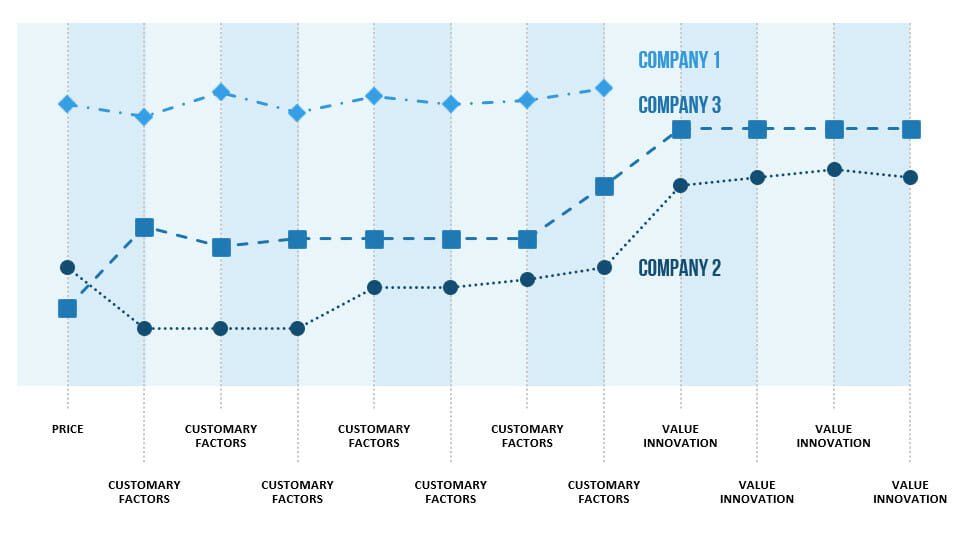
By using a value curve, you create a direct comparison between your company and a competitor. The graphical representation as a value curve makes success quantifiable. The value curve emerges from the previously posed and analyzed questions. This allows you to visualize the value creation curve.
The core elements of the product are visualized, highlighting possibilities for modifying products and exploring new markets. You arrange various features of your product along one axis, symbolizing their importance or degree of manifestation. The diagram depicts the core elements of a product on the horizontal axis, while the vertical axis illustrates the degree of manifestation of these elements.
This enables you to represent the required changes in comparison to existing products in order to develop an innovation.
The ERRC Grid
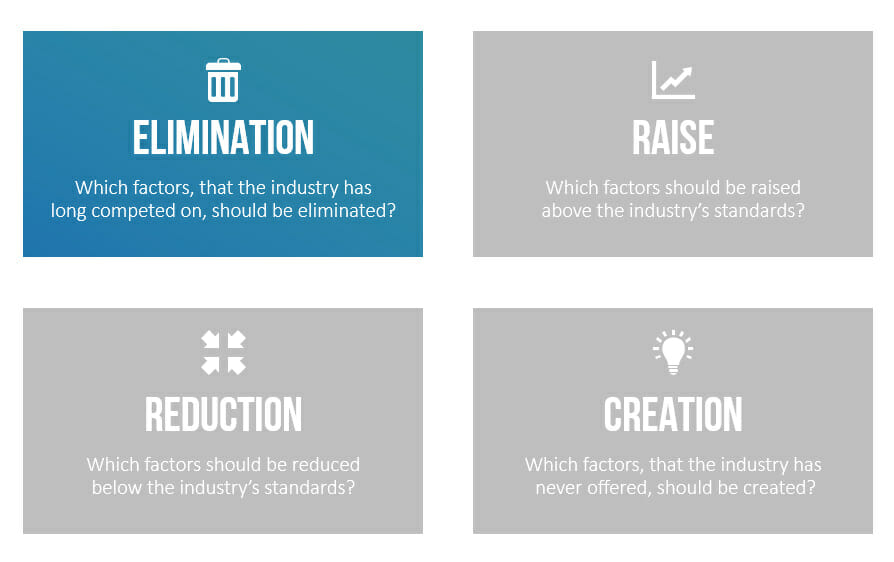
With the help of this tool, you can (re)define your value proposition. For a successful Blue Ocean Strategy, it is essential to consider the desires of your new target audience. Once these are known, the next step is to align your business idea with the customer’s needs.
This is where the ERRC (Eliminate-Reduce-Raise-Create) Grid comes into play. This business tool, also known as the Four Actions Framework, allows you to develop your business idea into a new innovative product and explore new markets using four actions.
The four actions are as follows:
- Eliminate: Here, you ensure that all factors that could be perceived as bothersome by potential customers are eliminated. The key questions to consider are:
What competitive factors considered as standard by the market can be eliminated?
Which factors, not essential to the core competency, can be eliminated?
Is there a cost factor that is not justified compared to the generated revenue?
- Reduce: Focus only on factors that are relevant to consumers. Reduce information to the essential elements. The key questions to consider are:
Which factors need to be reduced well below the market segment’s standard?
Are there components that the company cannot or does not want to completely eliminate?
Are there factors that are mere “followers” and not core components or defining characteristics of the product?
- Raise: Highlight the most important features of your product. The key questions to consider are:
Which factors need to be raised well above the market segment’s standard?
Which components of the company should be emphasized more?
- Create: Design new features of your product that provide high value to customers and are not yet known. The key questions to consider are:
Which factors that have not been offered by the market segment should be created?
What can be added to give your product or service an innovative value?
By applying these four actions, you can develop a unique value proposition that meets the needs of your target audience and differentiate yourself from competitors.
The Six Paths Framework
The Six Paths Framework helps you reshape market boundaries by considering different perspectives:
- Alternative Industries: What are the alternative industries to your products or services? What could trigger a shift for customers?
- Strategic Groups: Which strategic group does your company belong to? What factors could lead customers to switch from one group to another?
- Buyer Groups: What are the different buyer groups within the market segment?
- Complementary Products and Services: In what context is your product or service used?
- Functional and Emotional Motivations: Does the product have functional or emotional appeal?
- Sustainable Trends: Which trends will strongly impact your market segment, are irreversible, and are developing in a clear direction?
PMS (Product/Market Strategy) Matrix
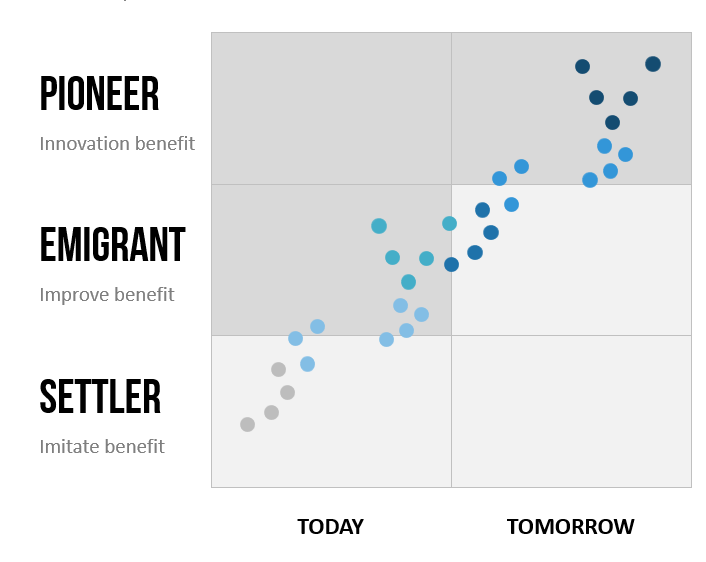
The PMS Matrix is a tool used to evaluate your existing and planned product portfolios. Based on the analysis results, you can realign your strategy.
The PMS Matrix categorizes the current and planned portfolios into the following three categories:
The size of each product/service is determined by the market volume or market potential.
Identifying Barriers
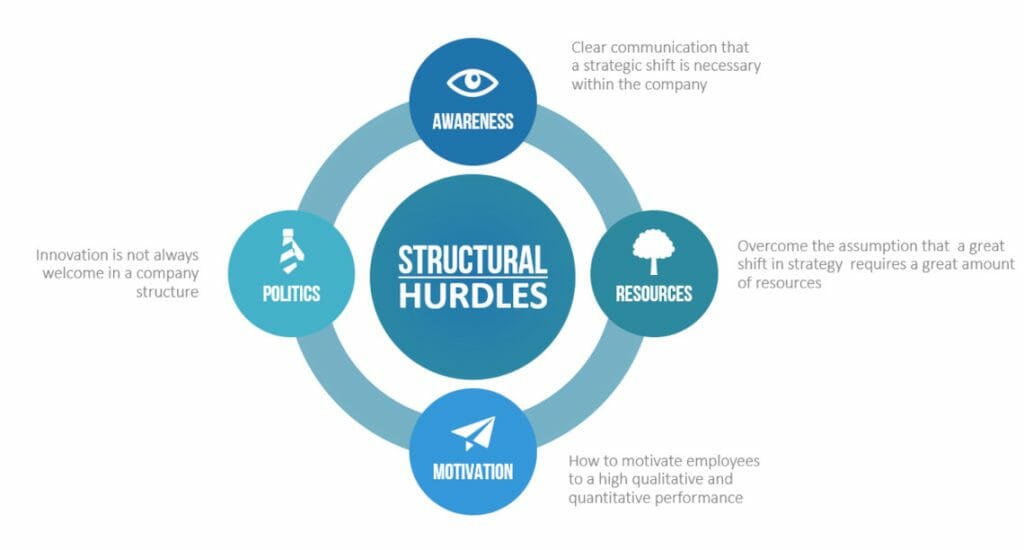
You need to be aware of and plan for the following barriers:
- Awareness Barrier: Clear communication is needed to convey that a change is taking place within the company and that it is necessary.
- Resource Barrier: Overcoming the power of habit. Significant changes would require substantial resources to break through.
- Motivation Barrier: Leaders must motivate their teams to achieve goals and deliver high-quality, high-performance outcomes.
- Political Barrier: Not all company structures and cultures are open to innovation.
In conclusion, be aware of these barriers and work to overcome them in order to launch your successful product in the Blue Ocean.
Here’s how you can visualize your Blue Ocean strategy using PowerPoint
Here’s how you can visualize your Blue Ocean strategy using PowerPoint. The combination of the tools can look like this:
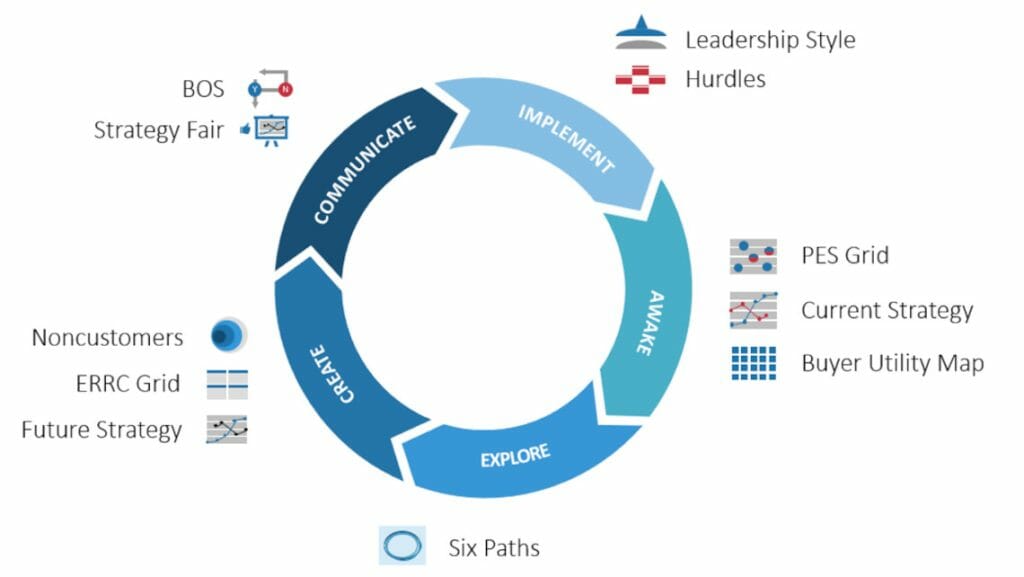
Feel free to use Blue Ocean strategy slides from PresentationLoad to enhance the visualization of your Blue Ocean strategy:
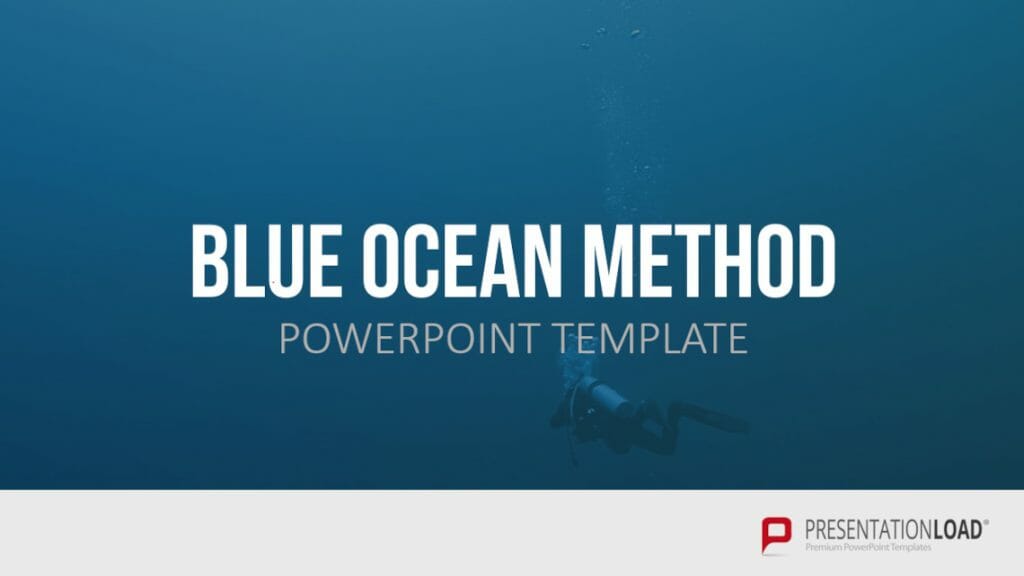
Successful Blue Oceans
- The Body Shop
The Body Shop utilized a new idea during its founding by focusing on sustainable packaging, animal welfare, and natural ingredients. This innovation brought them breakthrough success.
- Nintendo Wii
In 2006, Nintendo introduced the Wii to the market, following a carefully planned Blue Ocean strategy. Nintendo reduced the emphasis on graphics and computing power, stepping away from direct competition with Sony (PlayStation 3) and Microsoft (Xbox 360). By developing a new motion-controlled gaming concept, Nintendo created a new market that achieved tremendous success.
- Starbucks and McDonald’s
Starbucks implemented self-service as a Blue Ocean strategy. Starting in the United States and expanding globally, Starbucks continues to dominate the market with high-quality coffee in a cozy atmosphere. With the introduction of McCafé, McDonald’s successfully gained new customer groups through co-branding and built a new image. By reducing costs and offering self-service similar to Starbucks, McDonald’s appealed to customers.
- dm and Lush
The cosmetics chain “alverde” from the drugstore dm and the company LUSH distinguish themselves from other cosmetic companies by taking a completely different approach. Both brands consciously avoid a luxurious image and emphasize natural and ethically produced products.
Conclusion: Applying the Blue Ocean Strategy and Creating New Markets Skillfully
If you have a new innovative idea or want to explore new markets without competition, then embrace the Blue Ocean Strategy. Develop your product with expertise and tailor it to meet customer demands.
Utilize the presented methods to refine your product and achieve sustainable success.
If you have any questions about the Blue Ocean Strategy, feel free to reach out to us via email at [email protected]. We are here to assist you!
Are you looking for visually supportive and professionally designed slide templates? Browse through our shop, where we offer numerous slides ready for download on a wide range of (business) topics. Visit our shop today! ► Go to Shop
You may also be interested in these articles:




